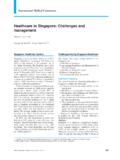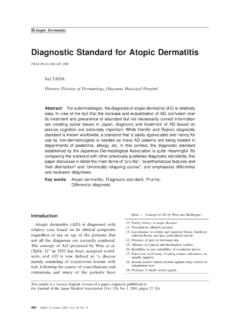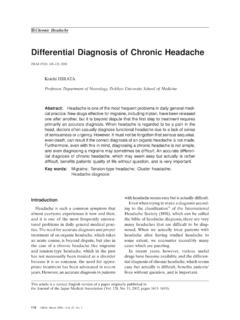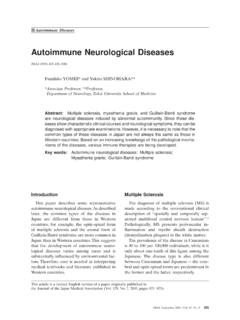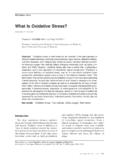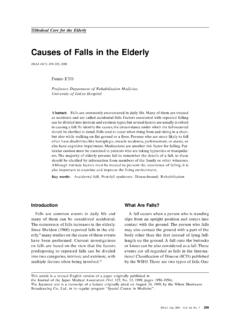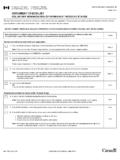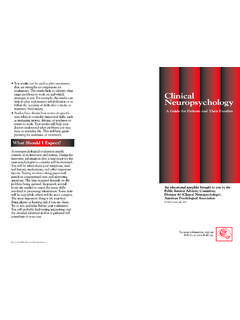Transcription of Differential Diagnosis of Chronic Kidney Disease (CKD): By ...
1 Research and Reviews Differential Diagnosis of Chronic Kidney Disease (CKD): By primary diseases JMAJ 54(1): 22 26, 2011. Shunya UCHIDA*1. Abstract In Japan, the number of patients with Chronic Kidney Disease (CKD) is estimated to be approximately 13 million. Of these, the number of dialysis patients, signifying the terminal stage of CKD, reached 282,000 at the end of 2008. Every year, over 37,000 CKD patients enter dialysis therapy due to diabetic nephropathy, Chronic glomeru- lonephritis, nephrosclerosis, polycystic Kidney Disease , or rapidly progressive glomerulonephritis (in descending order). Although the number of new dialysis patients due to Chronic glomerulonephritis is on the decline, the number of new cases attributable to diabetes, hypertension, and arteriosclerosis is on the rise.
2 In this paper, I. present and seek the current status and problems related to CKD in Japan by examining the primary diseases. Key words Chronic Kidney Disease (CKD), Diabetic nephropathy, Chronic glomerulonephritis, Nephrosclerosis, Drug-induced nephropathy Introduction The 5 Top Primary Diseases in New Dialysis Patients in the 2008 Survey Primary diseases of Chronic Kidney Disease (CKD) can be determined by examining the pri- According to the 2008 Survey, the 5 major pri- mary diseases of the patients who eventually mary diseases in new dialysis patients (excluding received dialysis treatment. According to a statis- unknown cases) as of December 2008 (Fig. 2) are tical survey conducted by the Japanese Society as follows: for Dialysis Therapy for Year 2008 (hereinafter 1st: diabetic nephropathy ( ).)
3 Referred to as the 2008 Survey), the total number 2nd: Chronic glomerulonephritis ( ). of patients undergoing dialysis treatment is more 3rd: nephrosclerosis ( ). than 282,000 as of December 31, 2008 (Fig. 1). 4th: polycystic Kidney Disease ( ). As is clear from the graph, the number of dialysis 5th: rapidly progressive glomerulonephritis ( ). patients has been increasing consistently year by Diabetic nephropathy has been ranked the year, with no sign of decline. There have been highest since 1998 when it overtook the previous approximately 37,000 new dialysis patients every top, Chronic glomerulonephritis, and gaining a year. The most common primary diseases respon- good lead ever since. Considering the recent sible for end-stage renal failure are; diabetic rapid increase in the prevalence of metabolic nephropathy, Chronic glomerulonephritis, neph- syndrome, the number of new dialysis patients rosclerosis, polycystic Kidney Disease , and rapidly due to diabetic nephropathy is likely to increase progressive glomerulonephritis (in descending further, which calls for urgent efforts and mea- order) (Fig.
4 2). sures from the viewpoint of CKD management. On the other hand, it is apparent that the number *1 Professor, Teikyo University School of Medicine, Tokyo, Japan (Fax: 81-3-3946-6295). This article is a revised english version of a paper originally published in the Journal of the Japan Medical Association ( , , 2009, pages 1521 1524). 22 JMAJ, January / February 2011 Vol. 54, No. 1. Differential Diagnosis OF Chronic Kidney Disease (CKD): BY PRIMARY DISEASES. Number of patients 300,000. 282,622. 275,119. 264,473. 257,765. 250,000 248,166. 237,710. 229,538. 219,183. 206,134. 200,000 197,213. 185,322. 175,988. 167,192. 154,413. 150,000 143,709. 134,298. 123,926. 116,303. 103,296. 100,000. 88,534 *. 83,221. 80,553. 73,537. 66,310. 59,811. 53,017. 47,978.
5 50,000 42,223. 36,397. 32,331. 27,048. 22,579. 18,010. 13,059. 9,245. 6,148. 3,631. 215 301 949 1,826. 0. 68/ 69/ 70/ 71/ 72/ 73/ 74/ 75/ 76/ 77/ 78/ 79/ 80/ 81/ 82/ 83/ 84/ 85/ 86/ 87/ 88/ 89/ 90/ 91/ 92/ 93/ 94/ 95/ 96/ 97/ 98/ 99/ 00/ 01/ 02/ 03/ 04/ 05/ 06/ 07/ 08/. 04 04 12 12 12 12 12 12 12 12 12 12 12 12 12 12 12 12 12 12 12 12 12 12 12 12 12 12 12 12 12 12 12 12 12 12 12 12 12 12 12. Year/Month * The recovery rate of the Year 1989 questionnaire survey was exceptionally low (at 86%), resulting in a seeming lower number of patients compared to other years. [Data Source: The Japanese Society for Dialysis Therapy (2009)1: ]. Fig. 1 Changes in the number of Chronic dialysis patients of patients with end-stage renal failure result- particularly obvious for acute glomerulonephritis ing from Chronic glomerulonephritis has been and membranoproliferative glomerulonephritis.
6 Decreasing gradually in recent years. Another possible factor is that drug treatment Various factors may be responsible for the for Chronic glomerulonephritis has become more decrease in dialysis patients due to Chronic glom- successful, including the result of so-called cock- erulonephritis. One reason is that overall infec- tail treatment that uses a combination of adreno- tions themselves, in which the occurrence of cortical steroid therapy, antiplatelet therapy, and nephritis is involved, have been decreasing as anticoagulant therapy. Furthermore, as a result public hygiene improves. This trend is said to be of tonsillectomy and steroid pulse therapy, not JMAJ, January / February 2011 Vol. 54, No. 1 23. Uchida S. (%). 70. Diabetic nephropathy Chronic glomerulonephritis Nephrosclerosis 60.
7 Polycystic Kidney Disease Rapidly progressive glomerulonephritis 50. 40. 30. 20. 10. 0. 1983 84 85 86 87 88 89 90 91 92 93 94 95 96 97 98 99 00 01 02 03 04 05 06 07 08. (Year). [Extracted and modified from The Japanese Society for Dialysis Therapy (2009)1: ]. Fig. 2 Changes in the 5 major primary diseases in new dialysis patients by year only remission but even cure has become pos- linked with metabolic syndrome is also in the back- sible in patients with IgA nephropathy who ground. Arteriosclerosis not only induces cere- account for more than half of all patients with brovascular or cardiovascular diseases but also Chronic glomerulonephritis. increases renal disorders. This type of nephropathy, Another aspect that should be noted strongly which is now being perceived as arteriosclerosis- is the important role played by the annual school related nephropathy, follows a rapid course and urinalysis screening (for children of age 5 to 15 in has a poor prognosis.)
8 To be specific, it exhibits elementary and junior high schools in Japan). various phenotypes, including malignant hyper- I shall forgo the details here, but it is apparent tension, renovascular hypertension, ischemic that school urinalysis has contributed to the early nephropathy, and cholesterol embolism. detection and treatment of nephritis. Therefore, The fourth-ranked polycystic Kidney Disease it is recommended that urinalysis test be imple- often exhibits an autosomal dominant pattern of mented in all employee health examination and inheritance. As shown in Fig. 2, the number of complete physical examination for adults, in new dialysis patients resulting from this Disease addition to elementary and junior high schools. is almost the same every year.
9 A new treatment Nephrosclerosis, which is ranked the third, is method has been proposed, and the result is expected to become more common in the future. anxiously awaited. In fact in the USA, nephrosclerosis overtook Ranked the fifth is rapidly progressive glom- Chronic glomerulonephritis and has taken the erulonephritis, one of 5 clinical classifications second place. Population aging is one contribut- of primary renal diseases prescribed by the ing factor to the dominance of nephrosclerosis, of World Health Organization (WHO). As implied course; however, an increase in arteriosclerosis by its name, deterioration of renal function 24 JMAJ, January / February 2011 Vol. 54, No. 1. Differential Diagnosis OF Chronic Kidney Disease (CKD): BY PRIMARY DISEASES.
10 Table 1 Primary diseases in new dialysis patients in 2008. Primary Disease Total (%) Rank Chronic glomerulonephritis 8,602 2. Chronic pyelonephritis 274 10. Rapidly progressive glomerulonephritis 443 7. Nephropathy of pregnancy/pregnancy toxemia 81 18. Other unclassifiable nephritis 158 14. Polycystic Kidney Disease 918 6. Nephrosclerosis 3,936 4. Malignant hypertension 282 9. Diabetic nephropathy 16,126 1. Systemic lupus erythematosus nephritis 285 8. Amyloidal Kidney 187 13. Gouty Kidney 100 16. Renal failure due to congenital abnormality of metabolism 18 22. Renal/urinary tract tuberculosis 22 21. Renal/urinary tract calculus 66 19. Renal/urinary tract tumor 188 12. Obstructive urinary tract Disease 95 17. Myeloma 158 14. Renal hypoplasia 43 20.
